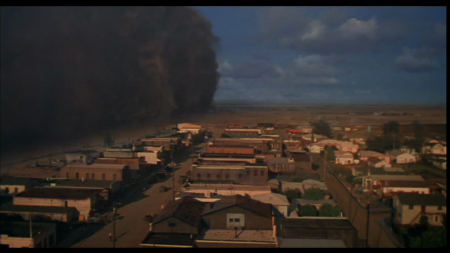
“You’ve got to have a good beginning,” Roger Corman told Scorsese as he prepared to shoot BOXCAR BERTHA, “because the audience wants to know what it’s about, and you’ve got to have a good ending, because they want to know how it all turned out. Nothing in between really matters.”
Scorsese would later call this, “The best sense I ever heard in pictures,” but at that time he was only able to fulfil the latter half of the success formula. BB opens with a really pathetic biplane crash (obviously an AIP feature could afford to crash a plane for real, so Scorsese cuts to horrified onlookers – he would make up for this in THE AVIATOR), but it ends with a cattle car crucifixion and a really dynamic shotgun massacre which has clearly been storyboarded and then executed faithfully – the wildest shot is the trackback POV of a guy who’s just been blasted off his feet by the shotgun. Compared to the bloodbath that climaxes TAXI DRIVER, it’s very cartoony, but effective. (And during the shoot, Barbara Hershey gave him a copy of Nikos Kazantzakis’ The Last Temptation of Christ.)
Scorsese’s struggle to maintain quality in his low-budget period romp is interesting to bear in mind when watching DILLINGER, which proved to be the best John Milius film I’ve ever seen. It never feels like they didn’t have enough time or money to do what they wanted to do, there are spectacular sequences (gun battles to beat HEAT) and beautiful shots, and not a bad performance in it – a considerable feet for a movie with scores of speaking parts, an inexperienced director, and a limited budget.
The very first shot (top) made Fiona cheer, and packs in more excitement and movie-star charisma than the whole ninety hours of Michael Mann’s PUBLIC ENEMIES – and it’s all done with Warren Oates’ expressive kisser and impactful comicbook composition. The Oates countenance: a kind of tapioca mudslide, like the bags under his eyes decided to strike out and form a face of their own. Everything is yielding to gravity, as if only loosely fastened to the crumbly skull beneath, and yet there’s a contradictory sense of hardness and permanence that stops you from thinking he’s about to disintegrate and pool on the floor this instant. The impression is of a real tough guy who can kill everyone in the joint between cigar puffs, but who carries his own eventual dissolution wrapped up inside that bullish carcass.
Milius/Oates’ Dillinger is amoral, charming and forceful, just as he should be. I did feel the lack of a real love story — what’s missing is an intro scene to the relationship with Billie Frechette (Michelle Philips — the plain one from the Mamas and the Papas — who has a great rake-thin 1930s shape and a great 1970s slouch) — Milius admitted not being too great at writing women, I believe. Here the couple just slap each other and he tears her dress off, and it’s rather hard to read this as the beginning of a great love story or anything other than plain brutality. As with most Milius films, there’s greater interest in bromance.

The real passion is between Dillinger and Melvin Purvis (Ben Johnson), the G-man who was sworn to smoke a cigar over his bullet-ridden corpse. The balance between twin protagonists — a device Milius tried again in THE WIND AND THE LION — works well here because it helps stop the story being purely a glorification of Dillinger. Despite the horror of the shoot-outs, JM probably IS in love with his outlaw protag (going on his form elsewhere) but we get to opt out if we want. It’s necessary, I think, to like Conan, but it’s not necessary to like Dillinger — you can get away with just finding him interesting, a compelling problem for society to solve.
In one nice, mythic scene, Melvin Purvis fails to impress a small boy at a shoeshine, demonstrating that being a G-man is nowhere near as cool (or lucrative) as being an outlaw. Especially if the outlaw is called Dillinger and the G-man is called Melvin Purves. This isn’t enough to motivate the man’s later suicide, but it’s one note of unease more than Michael Mann thought to supply — in his movie, it’s a complete mystery why he chose to disclose this fact about Purves (a very minor nonentity in his film).

Bonus Richard Dreyfuss, Harry Dean Stanton, Geoffrey Lewis (that moustache actually normalizes his weird Hanna-Barbera head!), Cloris Leachman.
Kurosawa influence (see also CONAN) very much in view — Johnson walks into a house where a bandit is staked out, we hear screams and shots, and the bloodied perp staggers out and dies — NOT in slomo, however. Milius evidently felt there was a limit to what he could steal. That’s what makes him different from his hero, I guess.










